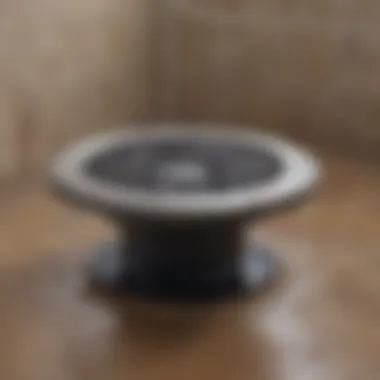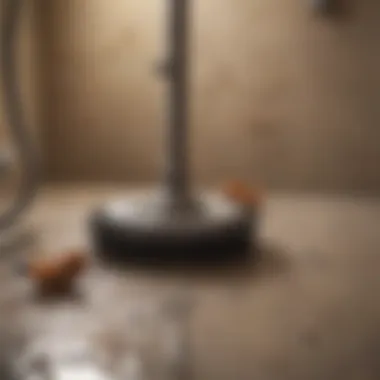Understanding and Managing Hair Blockages in Shower Drains


Intro
Hair blockages in shower drains are a problem that many homeowners encounter yet often overlook. These blockages can lead to significant plumbing issues, affecting both the functionality of the drain and the overall health of the plumbing system. Understanding the causes of hair accumulation is crucial for prevention and effective management. This guide will delve into the factors contributing to hair blockages, practical tips for preventing them, and proven methods for resolving existing clogs. By maintaining the plumbing systems, homeowners not only avoid inconveniences but also prolong the life of their plumbing infrastructure.
Featured Insights
While the focus is primarily on hair blockages in shower drains, it is also essential to consider the context of homes where these issues arise. Different architectural styles may influence plumbing layouts and, consequently, how easily blockages occur.
Architectural Styles
- Traditional Homes: Often feature basic plumbing systems that may not be equipped to handle frequent hair accumulation.
- Modern Designs: Tend to have more sophisticated drainage systems but can still suffer from clogs if maintenance is lacking.
Understanding the unique plumbing challenges associated with various architectural styles can help homeowners tailor their prevention methods appropriately.
Unique Design Elements
Certain design choices in bathrooms can exacerbate hair blockages.
- Open Showers: These designs, while visually appealing, can lead to faster hair buildup in drains due to the lack of barriers.
- Low Drainage Slope: If a drain is not angled properly, water may not flow efficiently, leading to increased chances of hair accumulation.
Addressing these design challenges is often overlooked but is critical in managing hair drainage issues before they become severe.
The Way Forward
Having an awareness of how various factors contribute to hair blockages empowers homeowners. Incorporating regular maintenance into one’s routine can prevent many issues before they start. This guide will not only highlight practical steps for unclogging drains but also emphasize long-term strategies aimed at promoting a cleaner, more functional plumbing system.
Preamble
Hair blockages in shower drains represent a significant yet often overlooked plumbing issue that can disrupt daily life. Understanding the complexities of how hair interacts with drainage systems is crucial for homeowners who wish to maintain their plumbing efficiency. This article delves into the causes of hair accumulation, offering practical insights and strategies for effective management.
The importance of addressing hair blockages cannot be understated. First, clogs can lead to slower drainage, resulting in water pooling in the shower, potentially causing slips and falls. Furthermore, ongoing blockages can escalate into more severe plumbing problems, including pipe damage or costly repairs.
By examining not only why hair accumulates but also how to prevent it, we provide homeowners with valuable information. Prevention methods, such as installing drain guards, are simple yet effective tactics that can save time and money in the long haul. Moreover, knowing how to identify early signs of blockage can facilitate quick intervention, mitigating the inconvenience caused by clogged drains.
This article will explore a range of topics including:
- The composition of hair and its interaction with water flow
- Common causes of hair blockages in showers
- Identification of blockage signs
- Prevention techniques and immediate solutions
- Long-term strategies for efficient drain management
The Nature of Hair and Drain Systems
Understanding the interaction between hair and drain systems is essential for effective management of potential blockages in shower drains. This knowledge helps homeowners recognize not only how blockages form but also the factors that exacerbate these issues. In both residential and commercial settings, effective drainage systems are crucial for maintaining hygiene and preventing water damage.
Hair, being a fibrous material that can tangle easily, poses unique challenges for plumbing. It can accumulate over time, leading to significant drainage problems. Recognizing the characteristics of hair and how it interacts with water is vital to prevent unwanted blockages.
Composition of Hair
Hair is primarily composed of a protein called keratin. This fibrous structure gives hair its strength and durability but also makes it sticky when wet. The individual strands can vary in thickness, texture, and length, contributing to how they behave when exposed to water flow. Hair's natural oils can also add to its stickiness, making it more likely to cling to other materials found in plumbing systems, such as soap residues or skin cells.
The accumulation of these materials upon hair leads to larger clumps that obstruct flow in drains. Moreover, the shedding patterns of human hair can lead to significant build-up, particularly in bathrooms where hair is lost during grooming activities. Every individual sheds around 50 to 100 strands of hair daily, depending on a variety of factors, including hair care practices and health.
How Hair Interacts with Water Flow


When hair enters the drain, it usually begins to move with the water. However, long hair or thick hair can easily become snagged in the bends and traps of plumbing systems. As water continues to flow, it can carry other debris such as soap, shampoo residues, and skin cells along with it. Hair's ability to clump with these materials increases the likelihood of blockages forming.
In general, water flow can be sluggish if hair accumulates significantly, indicating a potential blockage. The less free flow of water, the more likely debris will stick in the pipes. Blockages can occur in different plumbing systems, whether in residential or commercial properties, leading to costly repairs or maintenance issues. Being aware of how hair interacts with water can help homeowners implement effective prevention strategies to mitigate these risks.
Common Causes of Hair Blockages
Understanding the causes of hair blockages is crucial for homeowners. Knowing these factors helps in preventing clogs and managing plumbing issues more effectively. Hair is a primary contributor to drain blockages. Various elements lead to the accumulation of hair in shower drains. By identifying these causes, one can take proactive measures to minimize issues and maintain smooth water flow.
Human Hair Shedding Patterns
Every individual sheds hair daily. The amount varies among people. Factors include hair type, health, and seasonal changes. Average shedding ranges from 50 to 100 strands per day. In a household, this can quickly add up to significant amounts of hair. This shedding happens during normal routines like washing or conditioning hair. Understanding this pattern is essential. It shows how hair can gradually build up in the drain.
Differences in Hair Texture and its Effects
Hair texture plays a vital role in how hair interacts with water flow. Curly hair tends to catch more debris than straight hair. This can lead to faster blockages. Fine hair, while lighter, can also tangle and create clumps. Homeowners should be aware of the unique challenges their specific hair texture presents. This insight is helpful in devising tailored strategies for prevention. Different textures can lead to blockages at varying rates, affecting maintenance schedules directly.
Presence of Additional Materials
Hair does not act alone when it comes to blockages. Other materials contribute significantly. These include soap residue, skin cells, and bath products. Each of these factors can enhance the likelihood of clogs occurring. Being aware of this can lead to better cleaning strategies.
Soap Residue
Soap residue is a common contributor to drain blockages. It accumulates in pipes and mixes with hair to form stubborn clogs. The characteristic feature of soap residue is its sticky nature. This property makes it an effective binding agent. When hair sticks to the soap, a solid blockage forms. Using less soap or opting for different products can reduce this buildup. Homeowners should consider the products they use. Choosing specific, lower-residue soap formulations may prove beneficial in managing hair blockages.
Skin Cells
Skin cells are another contributor to drainage issues. They naturally slough off during daily activities such as showering. While each individual may not shed many cells, the collective effect adds up in the drain. This material, combined with hair, forms a dense mass that can be difficult to clear. Awareness of this aspect can encourage more regular cleaning, helping to ensure smoother drainage.
Bath Products
Bath products, such as scrubs and oils, also play a role. Many consumers are unaware that these products can contribute to blockages. Their key characteristic is viscosity and tendency to stick. When mixed with hair and soap, they can exacerbate clogging problems. Selecting lighter products or minimizing their use in the shower can help in managing blockages. The unique combination of ingredients in various bath products can lead to unexpected results in drainage systems.
Proactive measures can significantly reduce the risk of hair blockages in shower drains.
Identifying Signs of a Blocked Drain
Recognizing the signs of a blocked drain is crucial for any homeowner. Ignoring early symptoms can lead to more severe plumbing issues, necessitating costly repairs and extensive disruptions. Actively monitoring your shower drain’s performance is a key element in maintaining your plumbing system. By identifying these indicators early, you can save time, money, and inconvenience.
Slower Water Drainage
One of the first and most noticeable signs of a blocked drain is slower water drainage. When water takes longer than usual to flow down the drain, it suggests that something is obstructing the pipe. This obstruction may be a buildup of hair, soap, and other materials that accumulate over time. Regular drainage monitoring can help you detect this issue in its early stages. If water begins to pool around your feet while showering, it is a clear signal that remedial action is needed. Failing to address slow drainage can escalate the problem, leading to complete blockage in a short period.
Unpleasant Odors
Another critical sign of a blocked drain is the presence of unpleasant odors. If you notice foul smells emanating from your shower drain, it indicates an accumulation of organic matter and bacteria. These odors are often a telltale sign of stagnant water, which promotes mold and other unpleasant growth. Not only is this unsightly, but it can also pose health risks. Regular cleaning and a watchful eye on drainage can help mitigate these issues before they develop into more significant problems. It's important to address any bad smells promptly to maintain a comfortable and hygienic bathroom environment.
Gurgling Sounds
Gurgling sounds coming from your drain can also indicate blockage. When water struggles to flow past an obstruction, it may create air pockets and bubbles, which produce these unsettling noises. This sound often signifies that water cannot pass through the drain as it should, generating a backward flow of air. If you hear gurgling while using fixtures, it’s wise to investigate further, as this may lead to complete clogging if left unresolved. Early identification of this type of noise is essential in taking timely action to clear the blockage.
Addressing these signs of a blocked drain promptly can help you prevent larger plumbing disasters in the future.
Paying attention to these symptoms can not only protect your shower's functionality but also preserve the longevity of your plumbing system. We will discuss methods for prevention next.


Methods for Preventing Hair Blockages
Preventing hair blockages is imperative for maintaining the functionality of shower drains. The accumulation of hair can slow down water drainage, leading to unpleasant odors and even potential plumbing problems. By applying preventive measures, homeowners can save time and costs associated with drain cleaning services. In this section, we will discuss two primary methods: the installation of drain guards and regular maintenance practices.
Installing Drain Guards
Drain guards are an effective initial line of defense against hair blockages. These small, often mesh devices, sit over the drain opening, capturing hair before it enters the plumbing system. The key characteristic of drain guards is their simplicity. They are easy to install and typically require little effort to remove for cleaning.
Benefits of using drain guards include:
- Cost-effective prevention: A small upfront investment can save significant costs on professional drain cleaning.
- Ease of use: Most drain guards are straightforward to implement, making them accessible for any homeowner.
The unique feature of drain guards is their ability to catch hair while allowing water to flow freely. This means minimal interruption in water drainage. However, it's essential to clean the drain guard regularly to ensure it remains effective, as built-up debris can lead to new blockages.
Regular Maintenance Practices
Regular maintenance is crucial in preventing blockages before they occur. Implementing consistent cleaning routines can significantly extend the life of your plumbing system.
Routine Cleaning
Routine cleaning is the process of regularly inspecting and clearing hair and other debris from shower drains. This concept emphasizes consistency and can be incorporated into regular household cleaning schedules. The key characteristic of routine cleaning is its preventative nature; by addressing potential blockages before they worsen, homeowners can maintain optimal drainage levels.
A few reasons to prioritize routine cleaning include:
- Improved water flow: Regularly clearing hair can prevent slow drainage.
- Odor control: Keeping drains clean minimizes foul smells associated with stagnant water and debris.
The unique feature of routine cleaning is its adaptability. Homeowners can choose how often to inspect their drains based on usage patterns. However, it does require diligence and commitment. Skipping these tasks can lead to severe blockages.
Periodic Drain Inspections
Periodic drain inspections focus on a more thorough evaluation of the plumbing system. This involves checking conditions deep within the plumbing, looking for signs of buildup that may not be visible from the surface. The key aspect of periodic drain inspections lies in their proactive approach. Addressing potential issues early can save significant hassle and expense.
Benefits of periodic inspections include:
- Early detection of problems: Identifying issues before they escalate can prevent costly repairs.
- Expert evaluation: Often, engaging a professional for inspections can reveal concerns you may overlook.
The unique feature of periodic inspections is that they combine knowledge with experience. Professionals may use specialized tools to examine the plumbing system thoroughly. However, many homeowners may find this approach less convenient due to its frequency and potential costs involved.
Immediate Solutions for Blocked Drains
When faced with a blocked shower drain, prompt action is essential. Hair blockages can quickly escalate into more significant plumbing issues if not handled swiftly. Immediate solutions help restore normal water flow and prevent further complications, such as unpleasant odors or even plumbing failures. By addressing these blockages without delay, homeowners can minimize long-term damage and maintain their plumbing systems effectively.
Manual Removal Techniques
Using a Plumber's Snake
A plumber's snake, also referred to as a drain auger, is a tool designed to clear clogs in pipes. This tool allows for deeper penetration into the plumbing system than other methods, making it particularly effective for hair clogs. One key characteristic of using a plumber's snake is its ability to reach beyond the immediate blockage, potentially addressing multiple issues within the same attempt.
Its popularity stems from its effectiveness in many situations. It's a reliable choice for individuals who prefer a hands-on approach to plumbing. However, one unique feature to consider is that using a plumber’s snake requires some practice. New users may find it challenging at first. The advantages include direct access and the potential for complete removal of blockages, while the primary disadvantage is its learning curve.
Hand Removal Options


Hand removal options are straightforward and allow for immediate contact with the clogged material. This method involves using gloves to reach into the drain to pull out visible hair and debris. The significant characteristic of this method is its simplicity. Often, no special tools are needed, making it an accessible solution for most homeowners.
One reason hand removal is popular is the low cost and the immediate effect it can have. It allows for a clear view of what is blocking the drain, as one removes hair and other materials directly. However, the unique feature here is that it is limited to clogs visible at the surface. For deeper blockages, hand removal may not be effective enough. While it can clear minor blockages quickly, it is not a long-term solution for persistent issues.
Chemical Drain Cleaners
Chemical drain cleaners provide another immediate solution for hair clog issues. These cleaners are formulated to dissolve organic materials, including hair. They typically work relatively quickly, which can be a significant advantage in emergency situations. Homeowners should, however, approach chemical drain cleaners with caution. They can be harsh and may damage pipes if used frequently. Understanding the specific product's ingredients is essential to ensure compatibility with the plumbing system. Chemical cleaners can be effective for immediate relief, but they should not replace regular maintenance and preventative measures.
Natural Remedies
Vinegar and Baking Soda
Vinegar and baking soda offer a natural alternative for unclogging drains. This method involves pouring a mixture of both into the drain, where it reacts to break down clogs. The key characteristic of this remedy is that it is non-toxic and environmentally friendly. Using vinegar and baking soda is a beneficial option for those concerned about harsh chemicals impacting their plumbing or the environment.
One unique feature of this method is its bubbling reaction, which can help dislodge debris in the drain. Its advantages include safety and ease of use. However, while it is effective for many, it might not resolve severe blockages.
Boiling Water
Boiling water is one of the simplest remedies for hair blockages. Pouring boiling water down the drain can help dissolve soap and hair clogs. The primary characteristic of this method is its ease and minimal cost, making it accessible for most homeowners.
Using boiling water is beneficial as it can quickly clear minor clogs without the need for special tools or chemicals. Its unique feature is effectiveness for certain types of blockages, particularly when combined with other remedies, such as vinegar and baking soda. However, it is less effective against stubborn clogs deep within the pipes.
Long-Term Solutions for Drain Management
Effective management of hair blockages in shower drains requires a long-term strategy aimed at prevention and responsive maintenance. This section emphasizes the significance of investing in solutions that not only address immediate clog issues but also ensure the continued functionality of drainage systems.
The advantages of implementing long-term solutions are several. First, they ultimately save homeowners money by reducing the frequency of emergency calls to plumbing services. Second, they preserve the integrity of plumbing systems, which can degrade from repeated clogs and chemical treatments. Finally, a preventive approach promotes convenience, ensuring that shower drains function smoothly without constant intervention.
Professional Plumbing Services
Opting for professional plumbing services is often a wise choice when considering long-term drain management. Licensed plumbers bring specialized knowledge and tools that exceed typical homeowner capabilities. They can accurately diagnose blockage causes and recommend and perform suitable solutions.
In the context of hair blockages, professionals can conduct thorough inspections to identify underlying issues like improper pipe installation or larger systemic faults that may contribute to recurring clogs. Moreover, performing regular maintenance checks can preempt potential problems, ensuring that drains undergo routine cleaning and repairs as needed. One should consider that while the cost may seem high initially, the long-term savings and peace of mind can outweigh these considerations.
Upgrading Drain Systems
Improving existing drain systems is another long-term solution worth consideration. Two main upgrades can significantly impact drain effectiveness: installing larger pipes and enhancing drainage design.
Installing Larger Pipes
One notable aspect of installing larger pipes is their capacity to accommodate greater volumes of water and debris. This change can significantly reduce the chances of blockages occurring. Commonly, a larger pipe means that hair and other debris are less likely to accumulate. This feature is beneficial for households with multiple members, as higher water flow can help divert any debris into municipal systems more efficiently. However, a key consideration is the potential costs involved in the installation process, which may require significant remodeling of existing plumbing.
Enhancing Drainage Design
Enhancing drainage design focuses on optimizing how water flows through plumbing systems. This upgrade includes modifying angles, adding innovative drainage solutions, and ensuring that shower drain configurations effectively channel water away from areas prone to clogging.
By optimizing these designs, homeowners can vastly improve drainage capabilities and thus reduce the likelihood of future hair blockages. One of the unique features of these enhanced configurations is their potential to integrate advanced materials that resist build-up. While they may be a more expensive option initially, the reduced risk of frequent blockages presents a financially sound choice in the long term.
End
In concluding this exploration of hair blockages in shower drains, it is crucial to emphasize the significance of a proactive approach in managing this common plumbing issue. Hair accumulation, while often seen as a minor inconvenience, can escalate to severe drain problems if not dealt with effectively. This article has highlighted various key elements related to the subject, offering insights into the causes, prevention methods, and both immediate and long-term solutions for drain management.
Understanding the nature of hair and its interaction with water flow is the first step in recognizing potential blockages. In addition, we have discussed the role of other materials, such as soap residue and skin cells, that contribute to clog formation. By raising awareness of these factors, homeowners can mitigate the risk of significant plumbing issues.
Implementing recommended prevention methods, like installing drain guards and maintaining regular cleaning schedules, can greatly reduce the likelihood of hair clogs. Simple actions can prevent complications down the line, saving time, effort, and potential expenses from professional plumbing services.
Moreover, knowing how to address blockages immediately with effective removal techniques and remedies provides homeowners with essential tools for immediate problem-solving. This knowledge fosters independence and empowers individuals to maintain their plumbing systems effectively.
In summary, being informed about hair blockages leads to better management practices. It allows individuals to appreciate their plumbing as a critical component of home maintenance. With thoughtful consideration and deliberate actions, homeowners can ensure their shower drains function optimally, minimizing inconvenience and enhancing overall hygiene.















